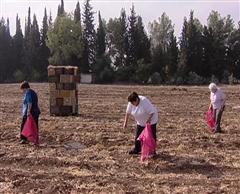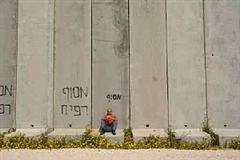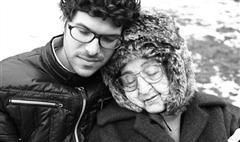Amos Gitai tells the story of his father, Munio Weinraub, who was a student at the Bauhaus design and architecture school in the city of Dessau, before Hitler closed the school in 1933. In May 1933, Weinraub was accused of “treason against the German people” and sent to prison and later on expulsed away from Germany. The film follows Munio’s route from Poland to Germany, from Switzerland to Palestine.
Archives
Good Garbage
The Hebron Hills garbage dump serves the Israeli settlements in the area and is a source of an eked-out livelihood for 200 Palestinian families from in and around the Palestinian village of Yatta. The stories of eleven-year-old Harun, seventeen-year-old Ibrahim, forty-year-old Yusuf, and sixty-year-old Badawi, expose a daily struggle for subsistence in an inescapable reality of occupation. These are the children of the Occupation, born after 1967, who know no other reality. The violent daily struggle for every scrap of metal in the dump distracts from other everyday pains: a son who sold lands to the Jews, a woman who cannot reunite with her family in Jordan, a father serving a life sentence in Israeli prison, and illiterate parents who push their children to work in the dump while simultaneously holding onto the dream of seeing them break out of the vicious cycle and completing a high-school degree. For the average person in Yatta, who has lost all faith in politics, personal success and education have become a personal weapon against the Occupation, one that might extricate them from the suffocating trap of the garbage dump, both literally and figuratively.
Gilad’s Liberation Army
Tsachi, Ella, Tsalik and Amir spent four years working for the release of the Israeli soldier, Gilad Shalit, who was kidnapped by Hamas militants from Gaza in 2006 and held incommunicado since then. Film director Ofra Gat-Yellin followed their efforts and became intimately involved with their work. Against the background of issues such as the Geneva code (POW rights), the privileges enjoyed by Hamas prisoners in Israeli jails, demonstrations at the Gaza border crossing points, and ‘collective punishment’ of the Gaza population, the activists realized how limited were their chances of influencing the events. At the same time they were guided by the Jewish principle: “Whoever saves one life – saves the world entire”. A glimmer of hope appeared when, after three years and as a result of the release of 10 female Hamas prisoners, Hamas offered a videotape showing Gilad talking to the camera. Toward the end of the third year of Gilad’s imprisonment, the Shalit family organized a march of protest from the family’s home in the Galilee to Jerusalem. Thousands joined. The march ended in front of the Prime Minister’s office in Jerusalem. There, at Tsachi’s initiative, a Tent of Protest was set up creating a demonstrative and continuous presence until, after more than five years in captivity, Gilad returned home.
Into Europe’s Backyard
Europe’s Muslims are in the midst of a social, political and religious storm. The encounter between cultures is fraught with heavy historical baggage and religious and nationalist fervor. This film follows the riots of 2005 and explors how Muslim separatism leads to religious extremism and concurrently to the radical right’s increased power.

Kibbutz
Kibbutz Hulata is located in the Upper Galilee. For 5 years Racheli Schwartz has been following the collapse and disintegration of her home. Most kibbutzim in Israel are in a vicious syndrome of economic collapse as well as ideological bankruptcy. This has caused the destruction of the very essential assets of kibbutz’s life: the dining room, the heart of the Kibbutz, where members met for meals, the communal laundry and the music room were all closed. Agriculture, the source of pride to a people returning to their land, is no longer profitable; orchards are being uprooted and the dairy is being dismantled. People become suspicious, isolated and begin to build fences around their homes. Yehuda is found hanged in the citrus plantation where he used to work. The dismantling of the Kibbutz had rendered him unemployed with no skills for other work. The film follows a number of members, each deeply influenced by the imminent death of the Kibbutz.
Let There Be Light
What goes through the mind of a young man who decides to fulfill his dream whatever the cost may be? Where lies the border between self fulfillment and staying loyal to your family?
In a unique documenting effort we join him for a full adventure that starts even before he concieves his plan, and until after he has to face its hard consequences back in Israel.

Luxuries

Life in Stills
At the age of 96, Miriam Weissenstein never imagined that she would be facing a new chapter in her life. But when “The Photo House” – her late husband Rudi’s life’s work – was destined for demolition, even this opinionated and uncompromising woman knew she needed help. Under the cloud of a family tragedy, a special relationship is forged between Miriam and her grandson, Ben, as they join forces to save the shop and its nearly one million negatives that document Israel’s defining moments. Despite the generation gap and many conflicts, Ben and Miriam embark on a heart-wrenching journey, comprising many humorous and touching moments.
Mendelsohn’s Incessant Visions
He made sketches on scraps of paper and sent them to the young cellist who awaited him in Berlin. She saw his genius and within several years helped him turn into the most sought-after architect in Germany. They wandered between continents and in every place he built, he left his mark.
No Full Stop
Shlomo Slutzky’s trip to Argentina to cover a former Junta general during the 1970’s surprisingly turns into a quest for Shlomo’s friends, who were imprisoned or exiled after joining the guerilla forces, and who feel betrayed by Shlomo for emigrating to Israel instead of helping them.
